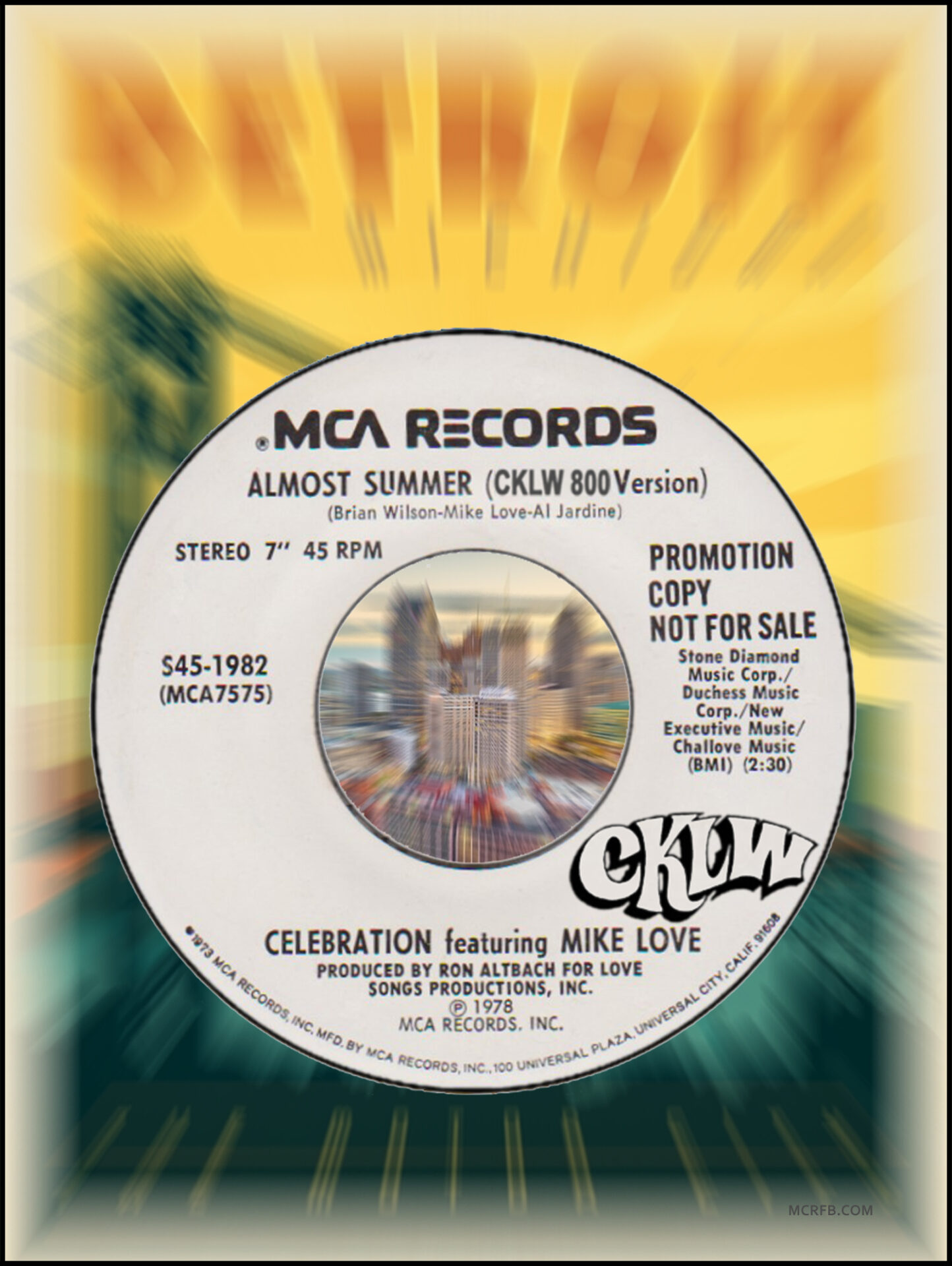
![]()
 Audio digitally enhanced by Motor City Radio Flashbacks
Audio digitally enhanced by Motor City Radio Flashbacks
![]()
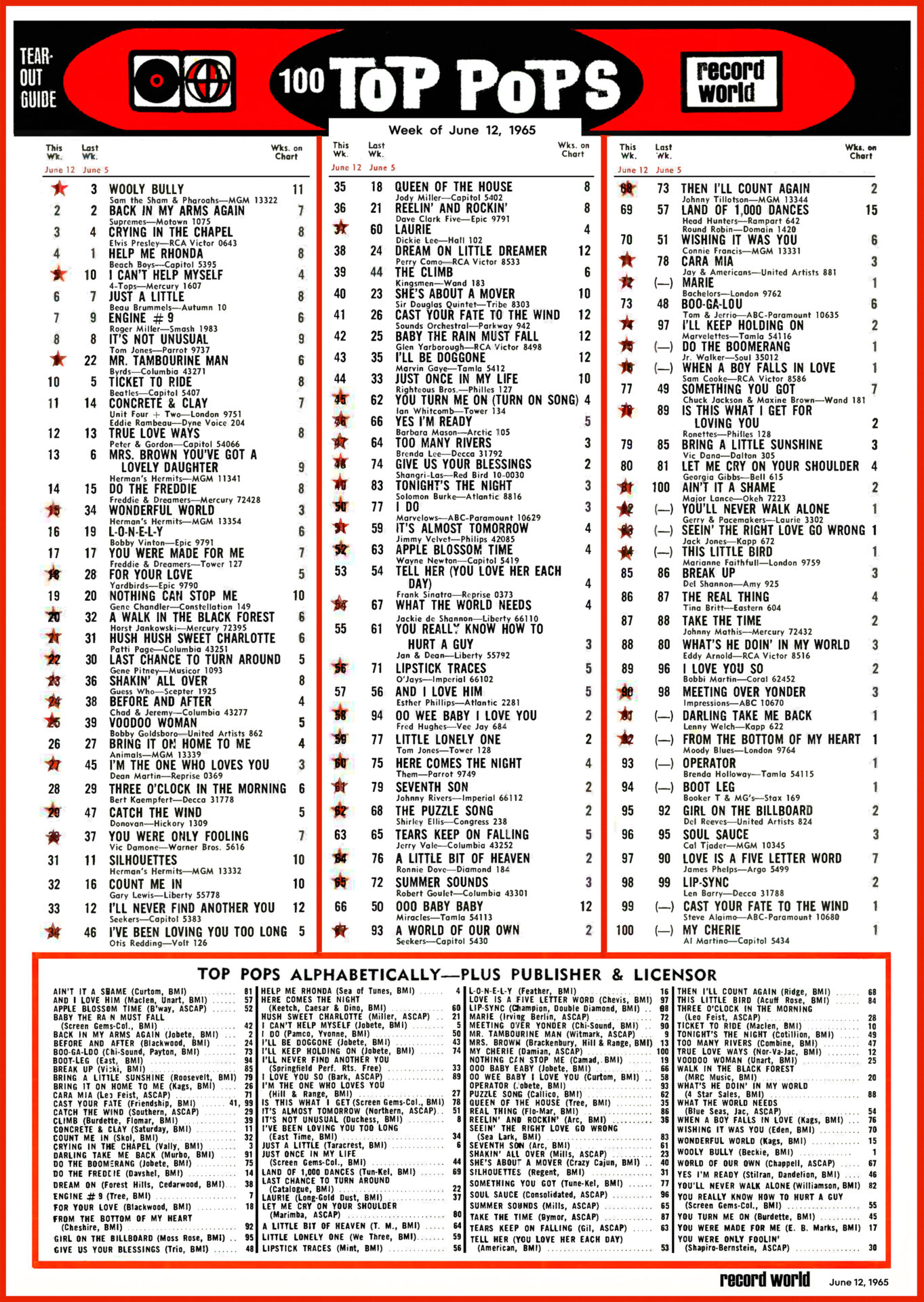
 Bob Austin, publisher, and Sid Parnes, editor-in-chief of Record World, and Sam Chase, publisher of Music Business, are pleased to announce the absorption of the publication Music Business and its assets into Record World. We believe that this association will be a strong, constructive force in the industry.
Bob Austin, publisher, and Sid Parnes, editor-in-chief of Record World, and Sam Chase, publisher of Music Business, are pleased to announce the absorption of the publication Music Business and its assets into Record World. We believe that this association will be a strong, constructive force in the industry.
It had been evident to us for sometime that four papers were proving to be a financial burden to the industry, thus limiting the growth of both publications. This step will not only eliminate that burden but will create a highly vital force by taking what has been most positive in both magazines and combining them into one strong entity. Because this combination reflects what, in our opinion, the industry has been requesting and looking forward to,we did everything in our means to achieve it.
Therefore, Music Business has now ceased publication, but many of its features will shortly be incorporated in a newly expanded Record World. There will also be an integration of staffs which will serve the industry as a knowledgeable and experienced working group.
 Record World will immediately embark on an extensive expansion program. With the amalgamation of staffs, we will be equipped to cover even more thoroughly every area of interest and use to those associated with the music and record fields.We intend to initiate projects that will be beneficial both to our readers and our advertisers and to reach into areas which are now either not being covered or only lightly touched upon.
Record World will immediately embark on an extensive expansion program. With the amalgamation of staffs, we will be equipped to cover even more thoroughly every area of interest and use to those associated with the music and record fields.We intend to initiate projects that will be beneficial both to our readers and our advertisers and to reach into areas which are now either not being covered or only lightly touched upon.
With the combination of Record World and Music Business circulations, we believe that we will now be able to offer the second highest paid circulation of any of the trade papers in our field. The strength of this circulation should make itself felt immediately. This move has been made by all the parties concerned in the interests of building a stronger paper for our industry and serving it in the most useful way possible.
_______________
![]() Information, credit, and news source: Record World June 12, 1965
Information, credit, and news source: Record World June 12, 1965

 The featured Record World charts were digitally re-imaged and restored by Motor City Radio Flashbacks
The featured Record World charts were digitally re-imaged and restored by Motor City Radio Flashbacks

![]()
 ON YOUR PC? You can read the above Record World charts ENLARGED. For a larger detailed view click both chart images 2x and open to second window. Click image anytime to return to NORMAL image size.
ON YOUR PC? You can read the above Record World charts ENLARGED. For a larger detailed view click both chart images 2x and open to second window. Click image anytime to return to NORMAL image size.
Click your server’s back button to return to MCRFB.COM home page.
ON YOUR MOBILE DEVICE? Tap over chart image. Open to second window. “Stretch” across your device screen to magnify for larger print view.

![]()
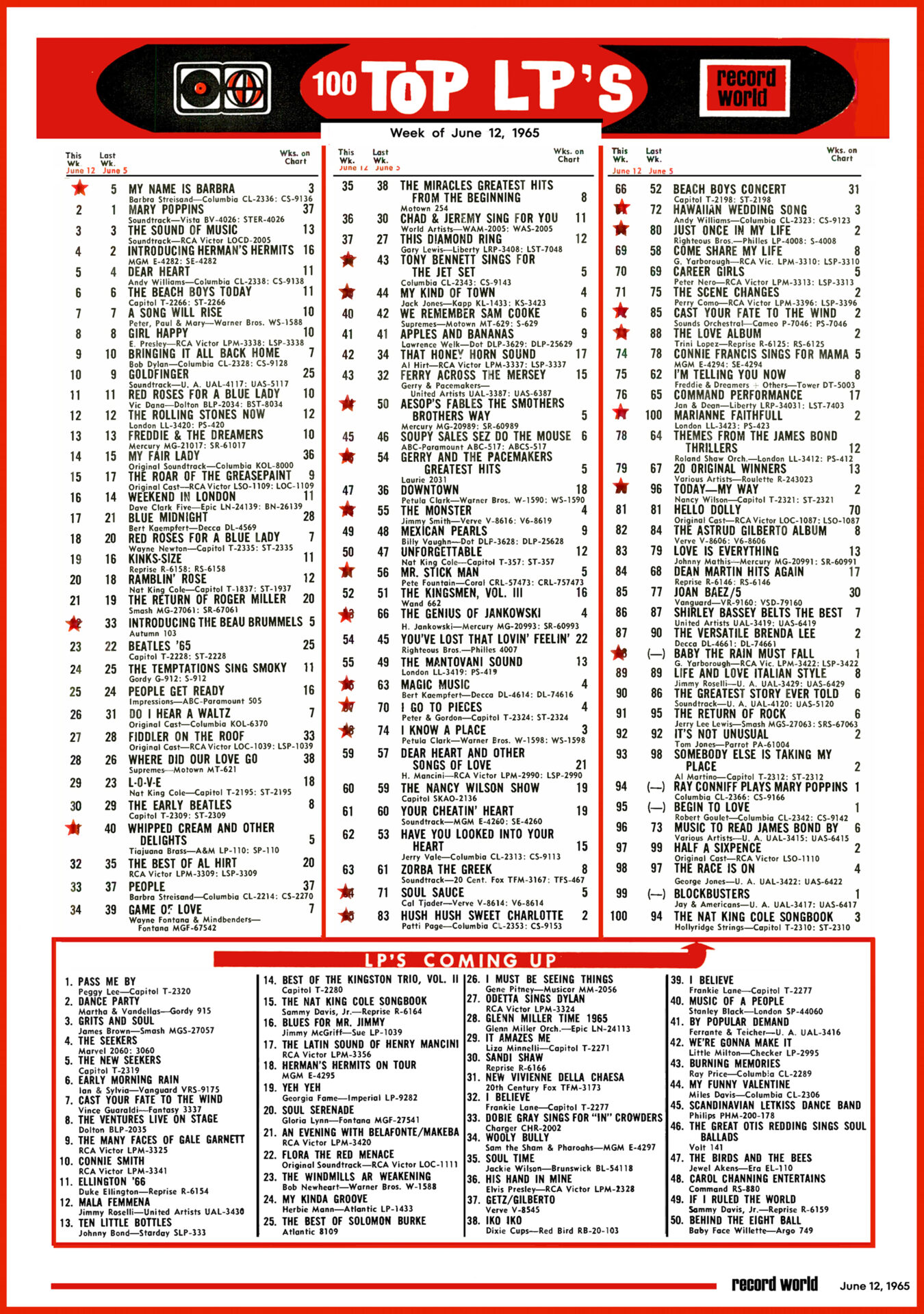
![]()
The above featured WHYT chart was digitally restored by Motor City Radio Flashbacks

![]()
![]() ON YOUR PC? To fully appreciate this WHYT FM June 9, 1986 chart feature click on image 2x and open to second window. Click image anytime to return to NORMAL image size.
ON YOUR PC? To fully appreciate this WHYT FM June 9, 1986 chart feature click on image 2x and open to second window. Click image anytime to return to NORMAL image size.
Click your server’s back button to return to MCRFB home page.
ON YOUR MOBILE DEVICE? Tap on chart image. Open to second window. “Stretch” across the featured survey to magnify largest print view.
A sincere thank you Mrs. Patti Griggs. This featured presentation would have not been possible without your generosity, dedication, and your continuous support.
Above WHYT music chart courtesy of Mrs. Patti Griggs and the George L. Griggs estate.
![]()
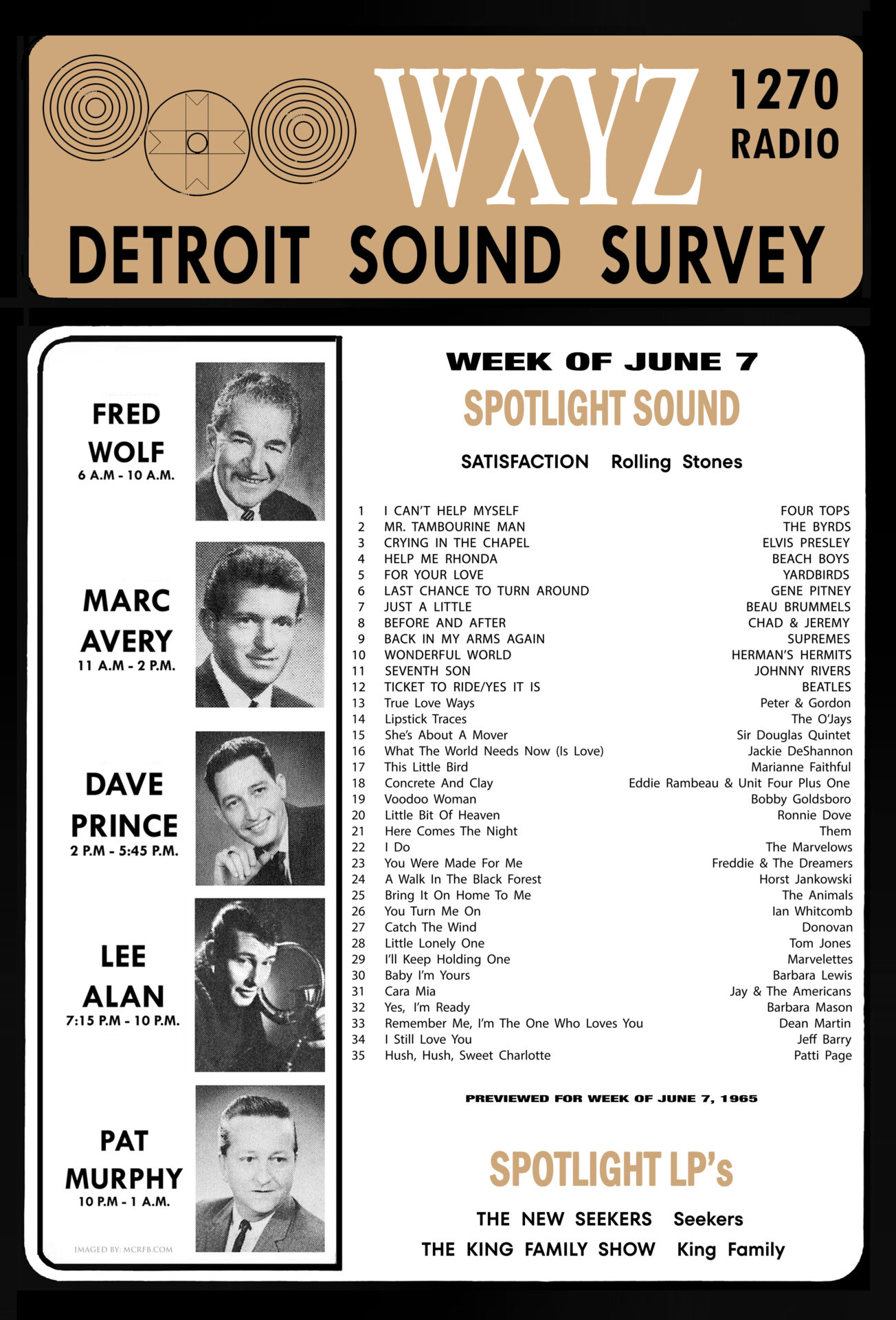
![]()
![]()
 ______________________________
______________________________
This list is selected each week by WXYZ Radio reports of records sales gathered from leading record outlets in the Detroit area and other sources available to WXYZ.
The above WXYZ 06/07/1965 chart survey was digitally restored completely in its entirety by Motor City Radio Flashbacks.
![]()
 By mid-January 1965, the Detroit Sound Survey charts was no longer printed for the public in general. The WXYZ charts, as featured above, were instead published solely for Detroit record retailers, music outlets, one-stop jobbers, and distributors only.
By mid-January 1965, the Detroit Sound Survey charts was no longer printed for the public in general. The WXYZ charts, as featured above, were instead published solely for Detroit record retailers, music outlets, one-stop jobbers, and distributors only.
These Radio 1270 top 40 charts was the largest of the WXYZ Detroit Sound Survey charts ever printed, having measured 17.5″ W x 22 L” inches in size. These charts were primarily used for weekly record rank based by popularity, position, retail sales, and were used for record retail rack displays as well.
For the very first time, Motor City Radio Flashbacks will be featuring a dozen or so — as chart dated — of these extremely rare WXYZ 1965 surveys throughout the year, 2024.
![]()
![]() ON YOUR PC? Click on chart image 2x for largest detailed print view.
ON YOUR PC? Click on chart image 2x for largest detailed print view.
ON YOUR MOBILE DEVICE? Tap over WXYZ chart image. Open to second window. “Stretch” chart across your device screen to magnify for largest detailed view.
![]()
![]()
![]()
![]() Normandy landings were the landing operations on Tuesday, 6 June 1944 of the Allied invasion of Normandy in Operation Overlord during World War II. Code named Operation Neptune and often referred to as D-Day, it was the largest seaborne invasion in history. The operation began the liberation of German-occupied France (and later Europe) from Nazi control, and laid the foundations of the Allied victory on the Western Front.
Normandy landings were the landing operations on Tuesday, 6 June 1944 of the Allied invasion of Normandy in Operation Overlord during World War II. Code named Operation Neptune and often referred to as D-Day, it was the largest seaborne invasion in history. The operation began the liberation of German-occupied France (and later Europe) from Nazi control, and laid the foundations of the Allied victory on the Western Front.
![]() Planning for the operation began in 1943. In the months leading up to the invasion, the Allies conducted a substantial military deception, code named Operation Bodyguard, to mislead the Germans as to the date and location of the main Allied landings. The weather on D-Day was far from ideal and the operation had to be delayed 24 hours; a further postponement would have meant a delay of at least two weeks as the invasion planners had requirements for the phase of the moon, the tides, and the time of day that meant only a few days each month were deemed suitable. Adolf Hitler placed German Field Marshal Erwin Rommel in command of German forces and of developing fortifications along the Atlantic Wall in anticipation of an Allied invasion.
Planning for the operation began in 1943. In the months leading up to the invasion, the Allies conducted a substantial military deception, code named Operation Bodyguard, to mislead the Germans as to the date and location of the main Allied landings. The weather on D-Day was far from ideal and the operation had to be delayed 24 hours; a further postponement would have meant a delay of at least two weeks as the invasion planners had requirements for the phase of the moon, the tides, and the time of day that meant only a few days each month were deemed suitable. Adolf Hitler placed German Field Marshal Erwin Rommel in command of German forces and of developing fortifications along the Atlantic Wall in anticipation of an Allied invasion.
![]() The amphibious landings were preceded by extensive aerial and naval bombardment and an airborne assault—the landing of 24,000 US, British, and Canadian airborne troops shortly after midnight. Allied infantry and armoured divisions began landing on the coast of France at 06:30. The target 50-mile (80 km) stretch of the Normandy coast was divided into five sectors: Utah, Omaha, Gold, Juno, and Sword. Strong winds blew the landing craft east of their intended positions, particularly at Utah and Omaha. The men landed under heavy fire from gun emplacements overlooking the beaches, and the shore was mined and covered with obstacles such as wooden stakes, metal tripods, and barbed wire, making the work of the beach-clearing teams difficult and dangerous. Casualties were heaviest at Omaha, with its high cliffs. At Gold, Juno, and Sword, several fortified towns were cleared in house-to-house fighting, and two major gun emplacements at Gold were disabled, using specialized tanks.
The amphibious landings were preceded by extensive aerial and naval bombardment and an airborne assault—the landing of 24,000 US, British, and Canadian airborne troops shortly after midnight. Allied infantry and armoured divisions began landing on the coast of France at 06:30. The target 50-mile (80 km) stretch of the Normandy coast was divided into five sectors: Utah, Omaha, Gold, Juno, and Sword. Strong winds blew the landing craft east of their intended positions, particularly at Utah and Omaha. The men landed under heavy fire from gun emplacements overlooking the beaches, and the shore was mined and covered with obstacles such as wooden stakes, metal tripods, and barbed wire, making the work of the beach-clearing teams difficult and dangerous. Casualties were heaviest at Omaha, with its high cliffs. At Gold, Juno, and Sword, several fortified towns were cleared in house-to-house fighting, and two major gun emplacements at Gold were disabled, using specialized tanks.
![]() The Allies failed to achieve any of their goals on the first day. Carentan, St. Lô, and Bayeux remained in German hands, and Caen, a major objective, was not captured until 21 July. Only two of the beaches (Juno and Gold) were linked on the first day, and all five beachheads were not connected until 12 June; however, the operation gained a foothold which the Allies gradually expanded over the coming months. German casualties on D-Day have been estimated at 4,000 to 9,000 men. Allied casualties were at least 10,000, with 4,414 confirmed dead.
The Allies failed to achieve any of their goals on the first day. Carentan, St. Lô, and Bayeux remained in German hands, and Caen, a major objective, was not captured until 21 July. Only two of the beaches (Juno and Gold) were linked on the first day, and all five beachheads were not connected until 12 June; however, the operation gained a foothold which the Allies gradually expanded over the coming months. German casualties on D-Day have been estimated at 4,000 to 9,000 men. Allied casualties were at least 10,000, with 4,414 confirmed dead.
![]() The Allies planned to launch the invasion on 1 May 1944. The initial draft of the plan was accepted at the Quebec Conference in August 1943. General Dwight D. Eisenhower was appointed commander of Supreme Headquarters Allied Expeditionary Force (SHAEF). General Bernard Montgomery was named as commander of the 21st Army Group, which comprised all land forces involved in the invasion. On 31 December 1943 Eisenhower and Montgomery first saw the plan, which proposed amphibious landings by three divisions with two more divisions in support. The two generals immediately insisted that the scale of the initial invasion be expanded to five divisions, with airborne descents by three additional divisions, to allow operations on a wider front and to speed the capture of Cherbourg. The need to acquire or produce extra landing craft for the expanded operation meant that the invasion had to be delayed to June. Eventually, thirty-nine Allied divisions would be committed to the Battle of Normandy: twenty-two US, twelve British, three Canadian, one Polish, and one French, totalling over a million troops all under overall British command.
The Allies planned to launch the invasion on 1 May 1944. The initial draft of the plan was accepted at the Quebec Conference in August 1943. General Dwight D. Eisenhower was appointed commander of Supreme Headquarters Allied Expeditionary Force (SHAEF). General Bernard Montgomery was named as commander of the 21st Army Group, which comprised all land forces involved in the invasion. On 31 December 1943 Eisenhower and Montgomery first saw the plan, which proposed amphibious landings by three divisions with two more divisions in support. The two generals immediately insisted that the scale of the initial invasion be expanded to five divisions, with airborne descents by three additional divisions, to allow operations on a wider front and to speed the capture of Cherbourg. The need to acquire or produce extra landing craft for the expanded operation meant that the invasion had to be delayed to June. Eventually, thirty-nine Allied divisions would be committed to the Battle of Normandy: twenty-two US, twelve British, three Canadian, one Polish, and one French, totalling over a million troops all under overall British command.
![]() The Normandy landings were the largest seaborne invasion in history, with nearly 5,000 landing and assault craft, 289 escort vessels, and 277 minesweepers participating. Nearly 160,000 troops crossed the English Channel on D-Day, with 875,000 men disembarking by the end of June. Allied casualties on the first day were at least 10,000, with 4,414 confirmed dead. The Germans lost 1,000 men. The Allied invasion plans had called for the capture of Carentan, St. Lô, Caen, and Bayeux on the first day, with all the beaches (other than Utah) linked with a front line 10 to 16 kilometres (6 to 10 mi) from the beaches; none of these objectives were achieved. The five beachheads were not connected until 12 June, by which time the Allies held a front around 97 kilometres (60 mi) long and 24 kilometres (15 mi) deep. Caen, a major objective, was still in German hands at the end of D-Day and would not be completely captured until 21 July. The Germans had ordered French civilians other than those deemed essential to the war effort to leave potential combat zones in Normandy. Civilian casualties on D-Day and D+1 are estimated at 3,000 people.
The Normandy landings were the largest seaborne invasion in history, with nearly 5,000 landing and assault craft, 289 escort vessels, and 277 minesweepers participating. Nearly 160,000 troops crossed the English Channel on D-Day, with 875,000 men disembarking by the end of June. Allied casualties on the first day were at least 10,000, with 4,414 confirmed dead. The Germans lost 1,000 men. The Allied invasion plans had called for the capture of Carentan, St. Lô, Caen, and Bayeux on the first day, with all the beaches (other than Utah) linked with a front line 10 to 16 kilometres (6 to 10 mi) from the beaches; none of these objectives were achieved. The five beachheads were not connected until 12 June, by which time the Allies held a front around 97 kilometres (60 mi) long and 24 kilometres (15 mi) deep. Caen, a major objective, was still in German hands at the end of D-Day and would not be completely captured until 21 July. The Germans had ordered French civilians other than those deemed essential to the war effort to leave potential combat zones in Normandy. Civilian casualties on D-Day and D+1 are estimated at 3,000 people.
Source, information and credit: D-Day Wikipedia
In the early morning hours of June 6, 1944, the CBS and NBC radio networks, centered in New York, took control of the day’s wartime news on all of their respective affiliated stations nationwide — special bulletins and all-day broadcasting of the reported allied invasion off the northern coast of France.
In 1944 the CBS Detroit affiliate was WWJ. The NBC Detroit (Blue Network) affiliate was WXYZ. These historic CBS (WWJ 950) and NBC (WXYZ 1270) broadcasts was heard in wartime Detroit over the radio, on this day, 80 years ago.
Audio portions for this presentation was selected from 24 continuous hours of these broadcasts (24 hours per network) we have in our archives. Today, Motor City Radio Flashbacks highlights the first three hours of the D-Day radio broadcasts as it was reported, respectively, on CBS and NBC radio, in the early-hours of Tuesday morning, June 6, 1944.
![]()
 On your mobile device? Tap over newspaper image. Open to second window. “Stretch” image across your device screen for digitized view.
On your mobile device? Tap over newspaper image. Open to second window. “Stretch” image across your device screen for digitized view.
On your PC? Click on the newspaper image 2x for detailed print view.
![]()
 ‘McCartney’ LP Number One; Beatles’ Let It Be’ Album Leaps to Number Two, Just Two Weeks on Billboard
‘McCartney’ LP Number One; Beatles’ Let It Be’ Album Leaps to Number Two, Just Two Weeks on Billboard
NEW YORK — Beatlemania — this time in the form of increased productivity from the group and individual members and in booming sales figures for Beatle product — is still alive and kicking. Beatles’ business manager, Allen Klein, revealed that 3.2 million copies of the group’s “Let It Be” album had been shipped in 13 days. At No. 2 on the Billboard album chart, this week, it jumped from 104 (May 31). Another Apple album, “McCartney,” by Paul McCartney, retains the top spot.
According to Klein, “Let It Be” is already the fourth best selling Beatle album. The list is headed by “Abbey Road” (about 5 million, said Klein), followed by their first ever U.S. album, “Meet the Beatles” (4.3 million) and “Hey Jude” (3.3 million). In fifth place, behind “Let It Be,” is “Sgt. Pepper,” usually regarded as the biggest Beatle seller (2.7 million).
 Pointing out that “Abbey Road,” “Hey Jude” and “Let It Be” are all recent product, Klein sees this as justification for the present Apple method of operation. “Since January, Apple has, in effect, taken a unique position in the record business, having total control of and responsibility for the amount of product to be manufactured and shipped,” he said. “Apple is an independent record company using wholly owned distribution and marketing procedures of another major record company. Apple takes all the risks of obsolescence and returns.
Pointing out that “Abbey Road,” “Hey Jude” and “Let It Be” are all recent product, Klein sees this as justification for the present Apple method of operation. “Since January, Apple has, in effect, taken a unique position in the record business, having total control of and responsibility for the amount of product to be manufactured and shipped,” he said. “Apple is an independent record company using wholly owned distribution and marketing procedures of another major record company. Apple takes all the risks of obsolescence and returns.
“The best evidence of the success of this type of distribution is in the enormously high sales of ‘Hey Jude’ which sold more in total than ‘Sgt. Pepper.’ And this sold without the usual amount of airplay that a new Beatle album or single gets because there was nothing new in the album.
“‘Abbey Road’ was less of a miracle because it was new product and had much airplay. And ‘Let It Be’ had two top singles and a film to help it along.”
Capitol, United Artist Praised
 Klein praised the resources of both Capitol and United Artists in contributing to the success of the “Let It Be” album. “We used Capitol’s manufacturing facilities to press 4 million-a million ahead, which is the risk that Apple takes. We drop shipped an initial 2.7 million, around 60 percent to major distributors and the rest to United Artist depots. We get daily information on key retail movement across the country so we know pretty quickly how things are shaping up.
Klein praised the resources of both Capitol and United Artists in contributing to the success of the “Let It Be” album. “We used Capitol’s manufacturing facilities to press 4 million-a million ahead, which is the risk that Apple takes. We drop shipped an initial 2.7 million, around 60 percent to major distributors and the rest to United Artist depots. We get daily information on key retail movement across the country so we know pretty quickly how things are shaping up.
“We have airplay in 40 percent of the country and with the film on release we managed to create the excitement of the release which is so important.
“We are now in a position of discussing what the potential sales of a Beatle album is, in a country of 200 million I don’t know — I reckon they should sell 20 million. But I do know that right now we have coordination. We are maximizing their potential.”
Klein has figures for other Beatle albums that were tied in — as is “Let It Be” –with films: “A Hard Day’s Night” (2.5 million), “Help” (1.5 million), “Magical Mystery Tour” (2 million) and “Yellow Submarine” (700,000).
Klein claims that the restructuring of Apple, freeing the Beatles from business duties, is the reason for the increased flow of material from the group. In the last 12 months the group has brought out five singles and three albums. Klein estimates the sales for that year at 13 million units in the U.S.
“This control they have in their own product is a spur to productivity,” he said. “The incentive to call their own shots means a lot. John Lennon finished ‘Instant Karma’ on a Friday and the record was in the shops the following Thursday. This is a great incentive to making records.”
Klein has reassurance for those surprised at the sales figures for the “Sgt. Pepper” album: “It is still selling a regular 50,000 copies a month. The Beatles catalog is also very strong. END
_______________
Information, credit, and news source: Billboard June 6, 1970
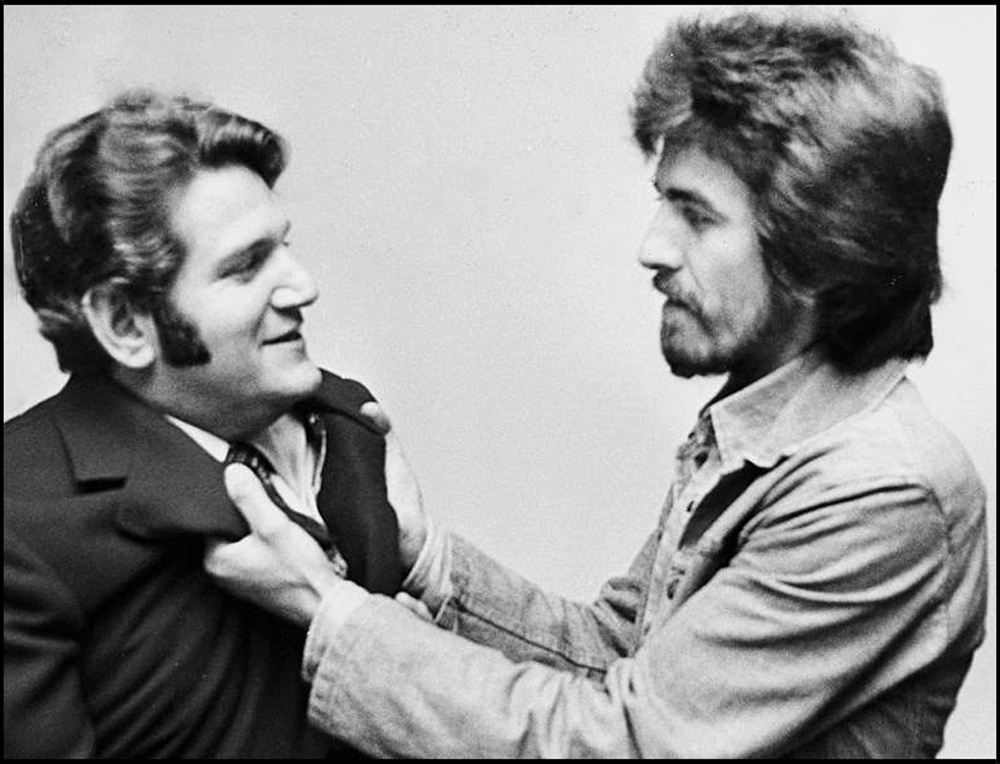
![]()
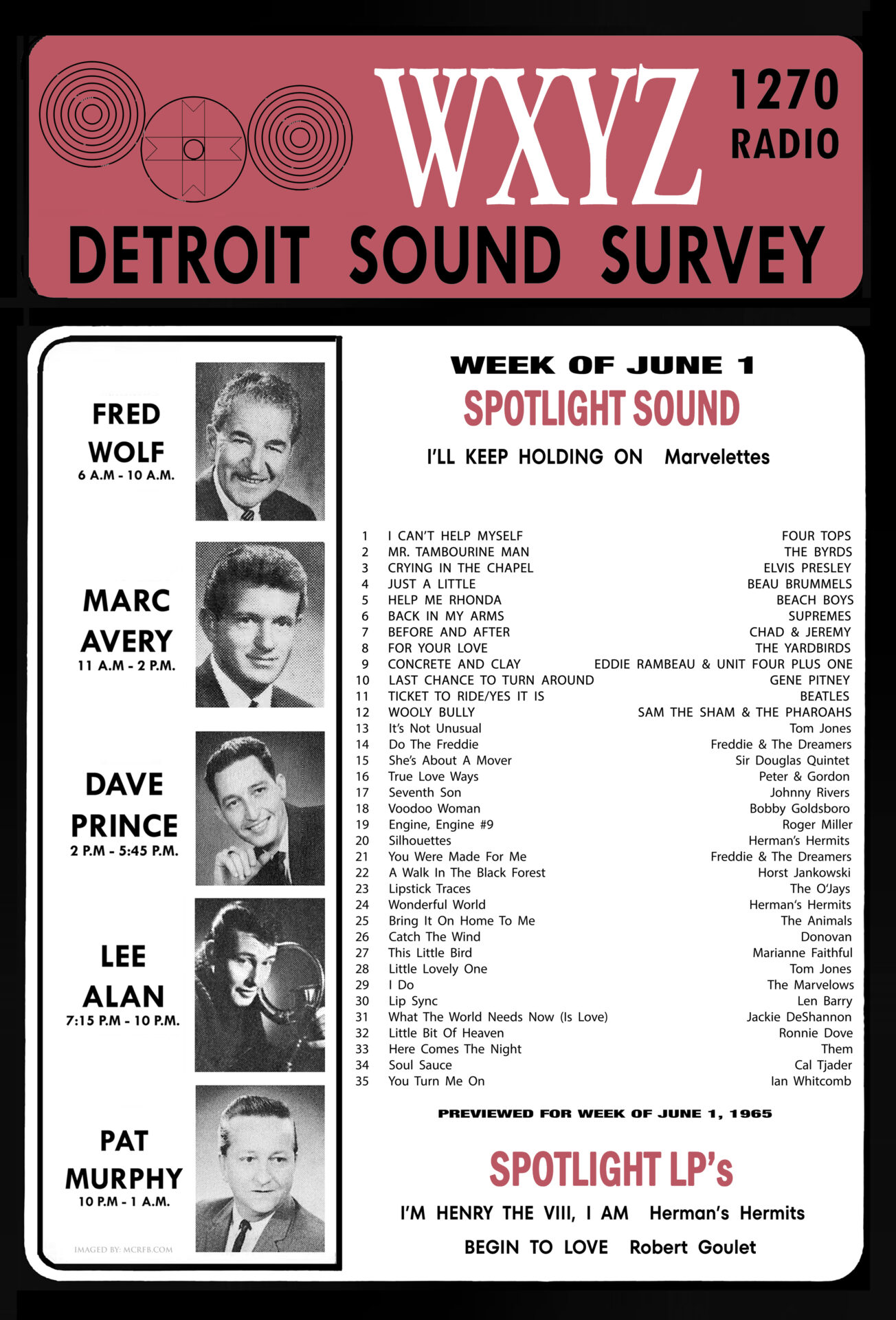
![]()
![]()
 ______________________________
______________________________
This list is selected each week by WXYZ Radio reports of records sales gathered from leading record outlets in the Detroit area and other sources available to WXYZ.
The above WXYZ 06/01/1965 chart survey was digitally restored completely in its entirety by Motor City Radio Flashbacks.
![]()
 By mid-January 1965, the Detroit Sound Survey charts was no longer printed for the public in general. The WXYZ charts, as featured above, were instead published solely for Detroit record retailers, music outlets, one-stop jobbers, and distributors only.
By mid-January 1965, the Detroit Sound Survey charts was no longer printed for the public in general. The WXYZ charts, as featured above, were instead published solely for Detroit record retailers, music outlets, one-stop jobbers, and distributors only.
These Radio 1270 top 40 charts was the largest of the WXYZ Detroit Sound Survey charts ever printed, having measured 17.5″ W x 22 L” inches in size. These charts were primarily used for weekly record rank based by popularity, position, retail sales, and were used for record retail rack displays as well.
For the very first time, Motor City Radio Flashbacks will be featuring a dozen or so — as chart dated — of these extremely rare WXYZ 1965 surveys throughout the year, 2024.

![]()
![]() ON YOUR PC? Click on chart image 2x for largest detailed print view.
ON YOUR PC? Click on chart image 2x for largest detailed print view.
ON YOUR MOBILE DEVICE? Tap over WXYZ chart image. Open to second window. “Stretch” chart across your device screen to magnify for largest detailed view.
![]()
![]()
![]()

![]() Audio digitally remastered by Motor City Radio Flashbacks
Audio digitally remastered by Motor City Radio Flashbacks
 In 1971, WKNR-FM shifted from its progressive rock format to “Stereo Island,” a blend of Beautiful Music and Middle of the Road styles, foreshadowing what would later be known as Soft Adult Contemporary. This transition proved successful, inspiring others like WFMK in Lansing, Michigan. By early 1972, both WKNR and WKNR-FM were sold. On April 25, 1972, at 8:00 a.m., WKNR-FM bid farewell to the Stereo Island format, rebranding as WNIC and WNIC FM. They began simulcasting a straightforward Beautiful Music format, with the call letters “WNIC” chosen to reflect the station’s commitment to “NICe” music. In 1976, WNIC embraced (48 years ago) a more lively tone dubbed “Rock ‘n’ Easy,” eventually evolving into its current (and much successful) adult contemporary format, a status those same call letters still maintains today.
In 1971, WKNR-FM shifted from its progressive rock format to “Stereo Island,” a blend of Beautiful Music and Middle of the Road styles, foreshadowing what would later be known as Soft Adult Contemporary. This transition proved successful, inspiring others like WFMK in Lansing, Michigan. By early 1972, both WKNR and WKNR-FM were sold. On April 25, 1972, at 8:00 a.m., WKNR-FM bid farewell to the Stereo Island format, rebranding as WNIC and WNIC FM. They began simulcasting a straightforward Beautiful Music format, with the call letters “WNIC” chosen to reflect the station’s commitment to “NICe” music. In 1976, WNIC embraced (48 years ago) a more lively tone dubbed “Rock ‘n’ Easy,” eventually evolving into its current (and much successful) adult contemporary format, a status those same call letters still maintains today.
![]()
![]() Partial information, presented in this post, was obtained from credited source: WNIC Wikipedia
Partial information, presented in this post, was obtained from credited source: WNIC Wikipedia
![]() The featured WKNR Stereo Island Jingle PAMS package is licensed, property of JAM, Incorporated. The PAMS logo and brand is licensed and marketed by JAM Productions, Dallas.
The featured WKNR Stereo Island Jingle PAMS package is licensed, property of JAM, Incorporated. The PAMS logo and brand is licensed and marketed by JAM Productions, Dallas.
![]()